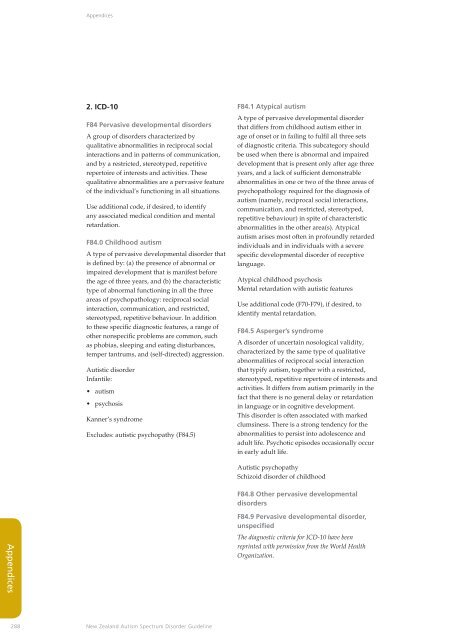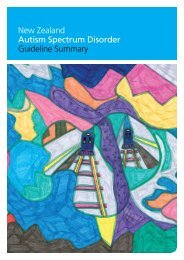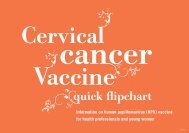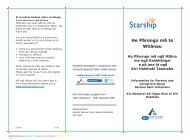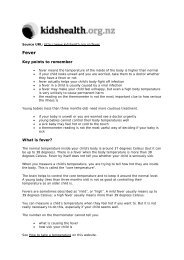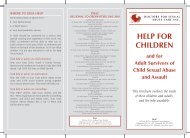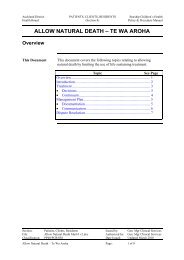New Zealand Autism Spectrum Disorder Guideline - Ministry of Health
New Zealand Autism Spectrum Disorder Guideline - Ministry of Health
New Zealand Autism Spectrum Disorder Guideline - Ministry of Health
You also want an ePaper? Increase the reach of your titles
YUMPU automatically turns print PDFs into web optimized ePapers that Google loves.
Appendices<br />
2. ICD-10<br />
F84 Pervasive developmental disorders<br />
A group <strong>of</strong> disorders characterized by<br />
qualitative abnormalities in reciprocal social<br />
interactions and in patterns <strong>of</strong> communication,<br />
and by a restricted, stereotyped, repetitive<br />
repertoire <strong>of</strong> interests and activities. These<br />
qualitative abnormalities are a pervasive feature<br />
<strong>of</strong> the individual’s functioning in all situations.<br />
Use additional code, if desired, to identify<br />
any associated medical condition and mental<br />
retardation.<br />
F84.0 Childhood autism<br />
A type <strong>of</strong> pervasive developmental disorder that<br />
is defined by: (a) the presence <strong>of</strong> abnormal or<br />
impaired development that is manifest before<br />
the age <strong>of</strong> three years, and (b) the characteristic<br />
type <strong>of</strong> abnormal functioning in all the three<br />
areas <strong>of</strong> psychopathology: reciprocal social<br />
interaction, communication, and restricted,<br />
stereotyped, repetitive behaviour. In addition<br />
to these specific diagnostic features, a range <strong>of</strong><br />
other nonspecific problems are common, such<br />
as phobias, sleeping and eating disturbances,<br />
temper tantrums, and (self-directed) aggression.<br />
Autistic disorder<br />
Infantile:<br />
• autism<br />
• psychosis<br />
Kanner’s syndrome<br />
Excludes: autistic psychopathy (F84.5)<br />
F84.1 Atypical autism<br />
A type <strong>of</strong> pervasive developmental disorder<br />
that differs from childhood autism either in<br />
age <strong>of</strong> onset or in failing to fulfil all three sets<br />
<strong>of</strong> diagnostic criteria. This subcategory should<br />
be used when there is abnormal and impaired<br />
development that is present only after age three<br />
years, and a lack <strong>of</strong> sufficient demonstrable<br />
abnormalities in one or two <strong>of</strong> the three areas <strong>of</strong><br />
psychopathology required for the diagnosis <strong>of</strong><br />
autism (namely, reciprocal social interactions,<br />
communication, and restricted, stereotyped,<br />
repetitive behaviour) in spite <strong>of</strong> characteristic<br />
abnormalities in the other area(s). Atypical<br />
autism arises most <strong>of</strong>ten in pr<strong>of</strong>oundly retarded<br />
individuals and in individuals with a severe<br />
specific developmental disorder <strong>of</strong> receptive<br />
language.<br />
Atypical childhood psychosis<br />
Mental retardation with autistic features<br />
Use additional code (F70-F79), if desired, to<br />
identify mental retardation.<br />
F84.5 Asperger’s syndrome<br />
A disorder <strong>of</strong> uncertain nosological validity,<br />
characterized by the same type <strong>of</strong> qualitative<br />
abnormalities <strong>of</strong> reciprocal social interaction<br />
that typify autism, together with a restricted,<br />
stereotyped, repetitive repertoire <strong>of</strong> interests and<br />
activities. It differs from autism primarily in the<br />
fact that there is no general delay or retardation<br />
in language or in cognitive development.<br />
This disorder is <strong>of</strong>ten associated with marked<br />
clumsiness. There is a strong tendency for the<br />
abnormalities to persist into adolescence and<br />
adult life. Psychotic episodes occasionally occur<br />
in early adult life.<br />
Autistic psychopathy<br />
Schizoid disorder <strong>of</strong> childhood<br />
F84.8 Other pervasive developmental<br />
disorders<br />
Appendices<br />
F84.9 Pervasive developmental disorder,<br />
unspecified<br />
The diagnostic criteria for ICD-10 have been<br />
reprinted with permission from the World <strong>Health</strong><br />
Organization.<br />
288<br />
<strong>New</strong> <strong>Zealand</strong> <strong>Autism</strong> <strong>Spectrum</strong> <strong>Disorder</strong> <strong>Guideline</strong>


